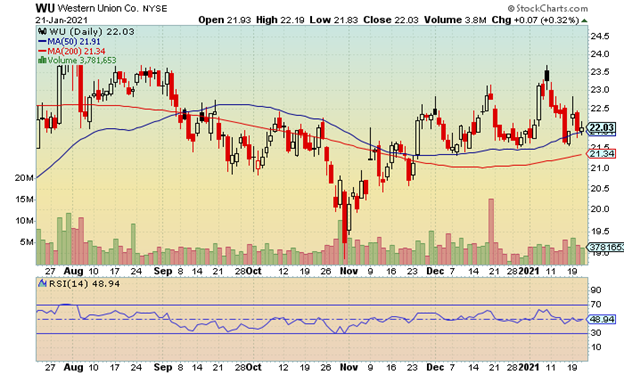With stock market valuations sitting near 20-year highs, investors are hoping corporate results and profit outlooks will help determine to what degree the valuations are justified. The catalyst that will drive the market to higher highs over the near-term will be the current fourth-quarter earnings season that will carry over into mid-February and a month in which it is always tricky to trade.
The financial sector started off the current cycle with mostly positive earnings and revenue beats. However, many stocks have come off their 52-week peaks despite stellar numbers.
In general, financial stocks have underperformed the broader market and were one of the hardest-hit sectors in 2020. Overall, the sector has provided investors with a total return of 4% over the past 12 months, with the Financial Select Sector Spider Fund (XLF) recently coming off its 52-week peak of $31.62 and prior levels from February 2020.
The sector has rallied this month on the back of positive coronavirus vaccine updates, and the h that a safe and effective vaccine will allow the economy to reopen. Additionally, the Federal Reserve just gave the big banks the go ahead to resume share buybacks in the first quarter of 2021, ending a six-month ban.
One specific stock that has lagged is Western Union (WU), which is currently trading around $22 and is down 22% from last January’s 52-week peak of $28.45. Shares recently hit an intraday high of $23.70 earlier this month but closed below $23.50.
Western Union has been holding its 50-day moving average since late November and could be setting up from another run at $23.50 if this trend continues to hold. Additionally, continued closes between $23.50–$23.75 could send shares towards a fresh breakout into the $24-$25 area.
The company recently announced some positive news and a new agreement with Walmart (WMT) that will, for the first time, enable Western Union money transfer services at Walmart locations across the United States. This will allow greater choice and value to millions of customers, with services including domestic and international money transfers, bill payments, and money orders.
Although this partnership won’t begin until this spring, Walmart’s 4,700 stores should provide a great foundation for more business throughout the rest of the year.
As far as earnings, the company is expected to report numbers in the second week of February. Analysts expect Western Union to earn a profit of 42 cents per share on revenue of $1.26 billion.
Over the past three quarters, the company has topped forecasts by $0.11, $0.06, and $0.03 per share, while missing by a nickel in the year-ago period. In October, the company said it expects fiscal year 2020 adjusted earnings of $1.80-$1.85, versus forecasts of $1.78 a share.
With a current dividend yield of 4% and an annual dividend payment of 90 cents per share, conservative traders should consider building positions at current levels. Aggressive traders can target the March 23 call options that are current trading for 65 cents.
If shares can make a run towards $24.30 by March 19th, these options will double from current levels, as they would be $1.20 “in-the-money”. The risk to the call option trade would be an earnings miss, shares falling below $21.25 at some point over the near-term.







